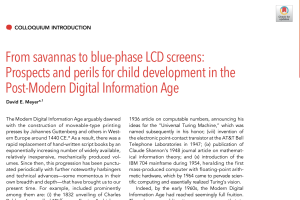Abstract
The Modern Digital Information Age arguably dawned with the construction of moveable-type printing presses by Johannes Guttenberg and others in Western Europe around 1440 CE.* As a result, there was a rapid replacement of hand-written script books by an exponentially increasing number of widely available, relatively inexpensive, mechanically produced volumes. Since then, this progression has been punctuated periodically with further noteworthy harbingers and technical advances—some momentous in their own breadth and depth—that have brought us to our present time. For example, included prominently among them are: (i) the 1832 unveiling of Charles Babbage’s so-called “Difference Engine,” which anticipated his subsequent “Analytical Engine,” a mechanical computing machine with several of the same basic features as modern electronic digital computers; (ii) the 1838 public demonstration of a nascent long-distance electrical telegraph designed by Samuel Morse, Leonard Gale, and Alfred Vail; (iii) Morse and Vail’s creation of American Morse Code, whereby the portentous message “What hath God wrought” was first transmitted as a sequence of acoustic dots and dashes in May 1844; (iv) incorporation of the Western Union Company in 1851; (v) David Hilbert’s challenge for participants at the 1900 International Congress of Mathematicians to formulate a finite, complete, consistent set of axioms for arithmetic of the natural numbers; (vi) Kurt Gödel’s proof, published in 1931, that there can be no such set of axioms; (vii) publication of Alan Turing’s visionary 1936 article on computable numbers, announcing his ideas for the “Universal Turing Machine,” which was named subsequently in his honor; (viii) invention of the electronic point-contact transistor at the AT&T Bell Telephone Laboratories in 1947; (ix) publication of Claude Shannon’s 1948 journal article on mathematical information theory; and (x) introduction of the IBM 704 mainframe during 1954, heralding the first mass-produced computer with floating-point arithmetic hardware, which by 1964 came to pervade scientific computing and essentially realized Turing’s vision. Indeed, by the early 1960s, the Modern Digital Information Age had reached seemingly full fruition. The advances enabling it were so awesome that, in toto, they led Marshall McLuhan—the iconic 20th century mass-media guru—to proclaim: “We are today as far into the electric age as the Elizabethans had advanced into the typographical and mechanical age. And we are experiencing the same confusions and indecisions which they had felt living simultaneously in two contrasted forms of society and experience”.
This article is part of a larger compilation of proceedings from “Digital Media and Developing Minds,” an interdisciplinary conference co-sponsored by Children and Screens and the National Academy of Sciences held in 2015. See a complete list of articles included in the proceedings.
